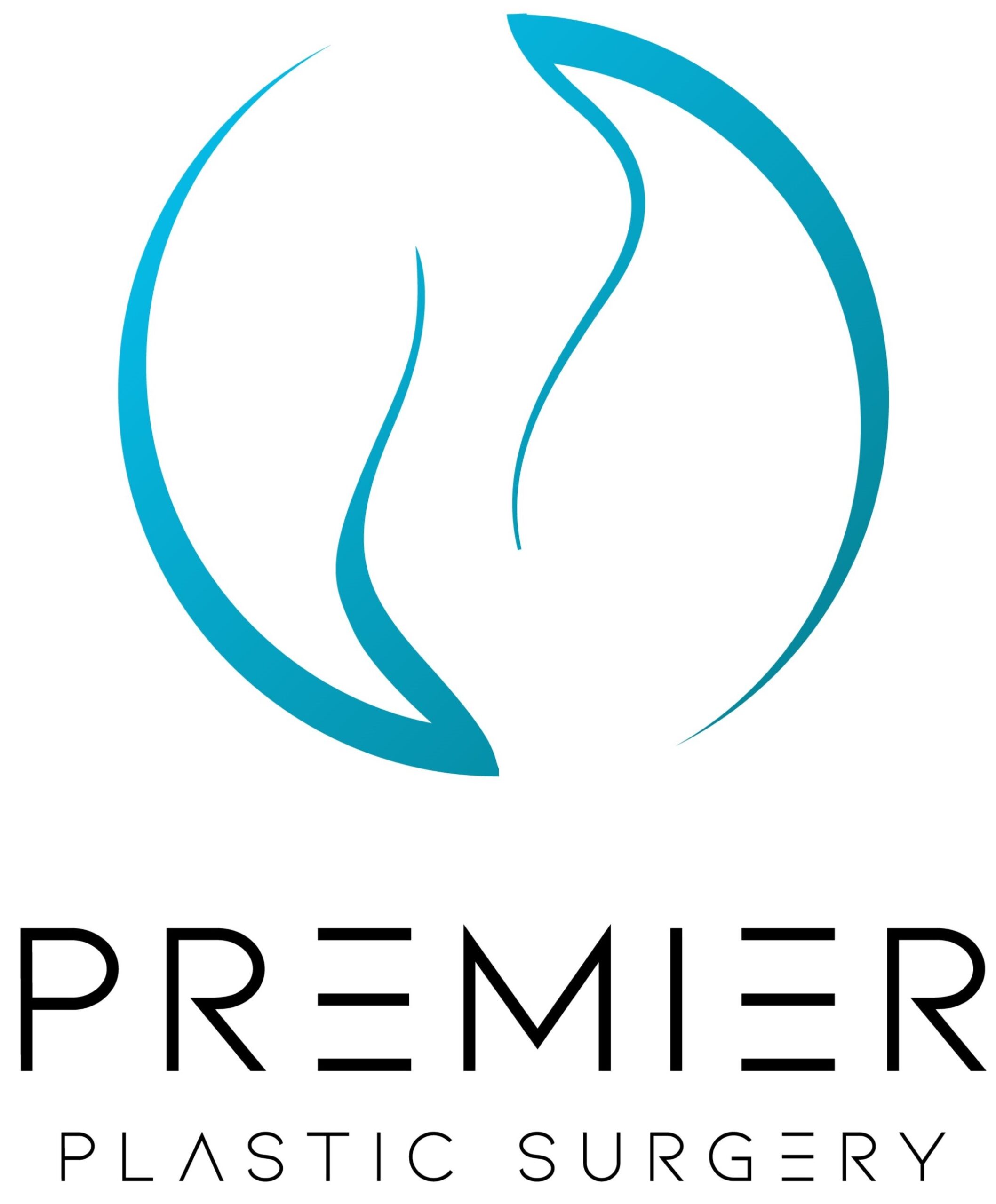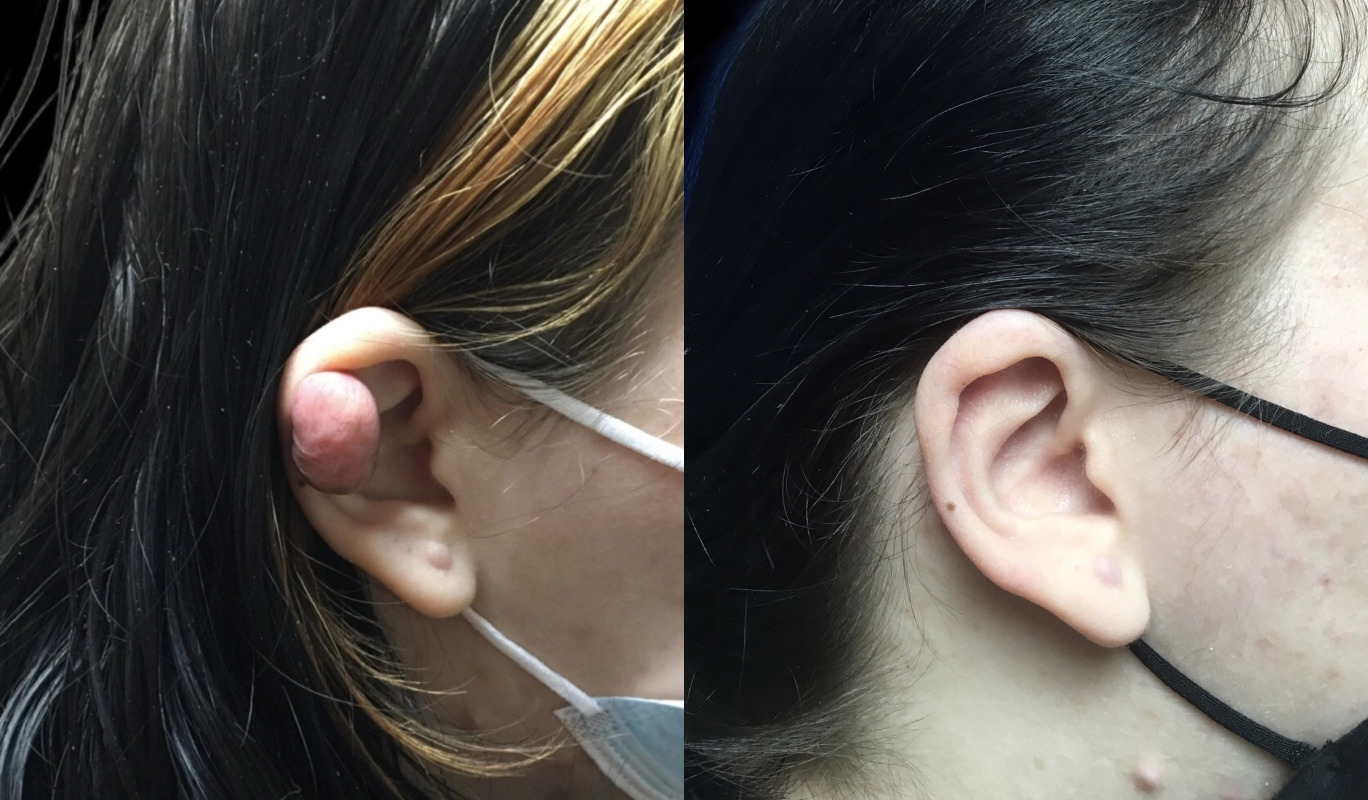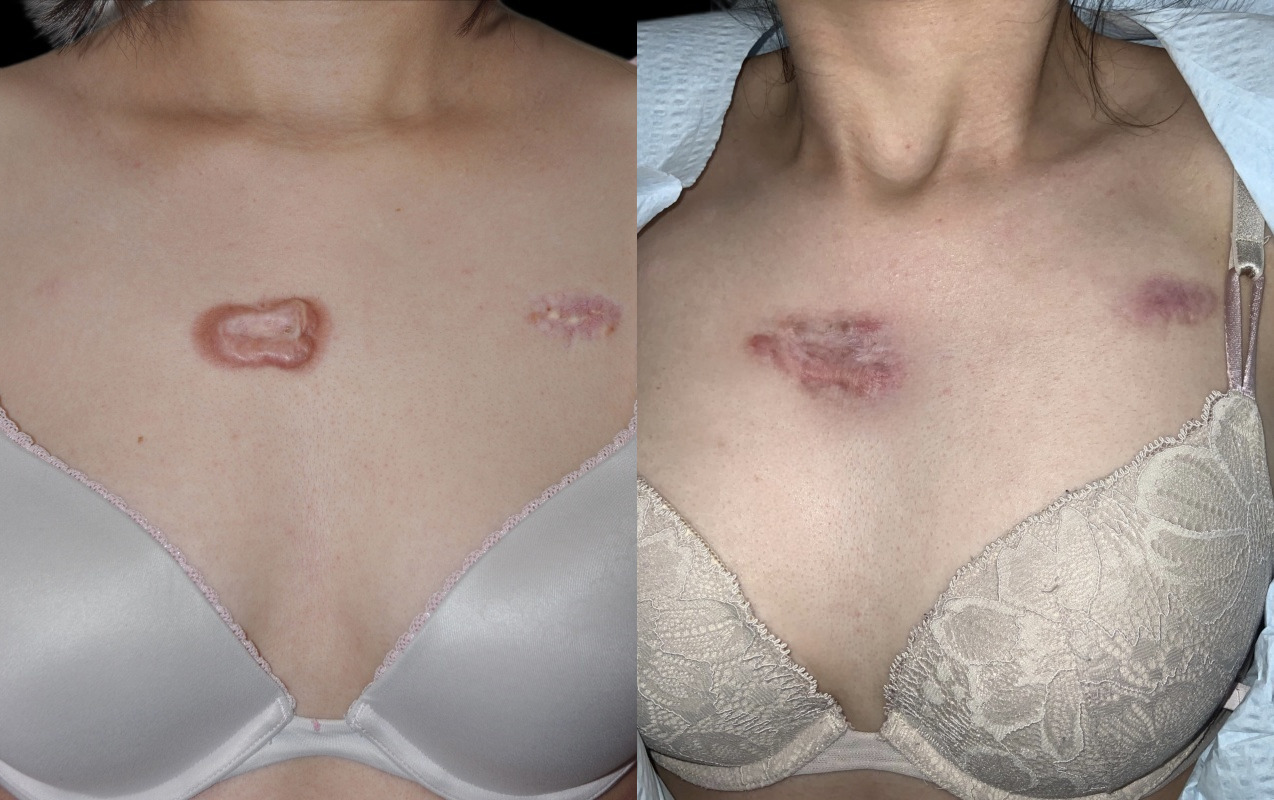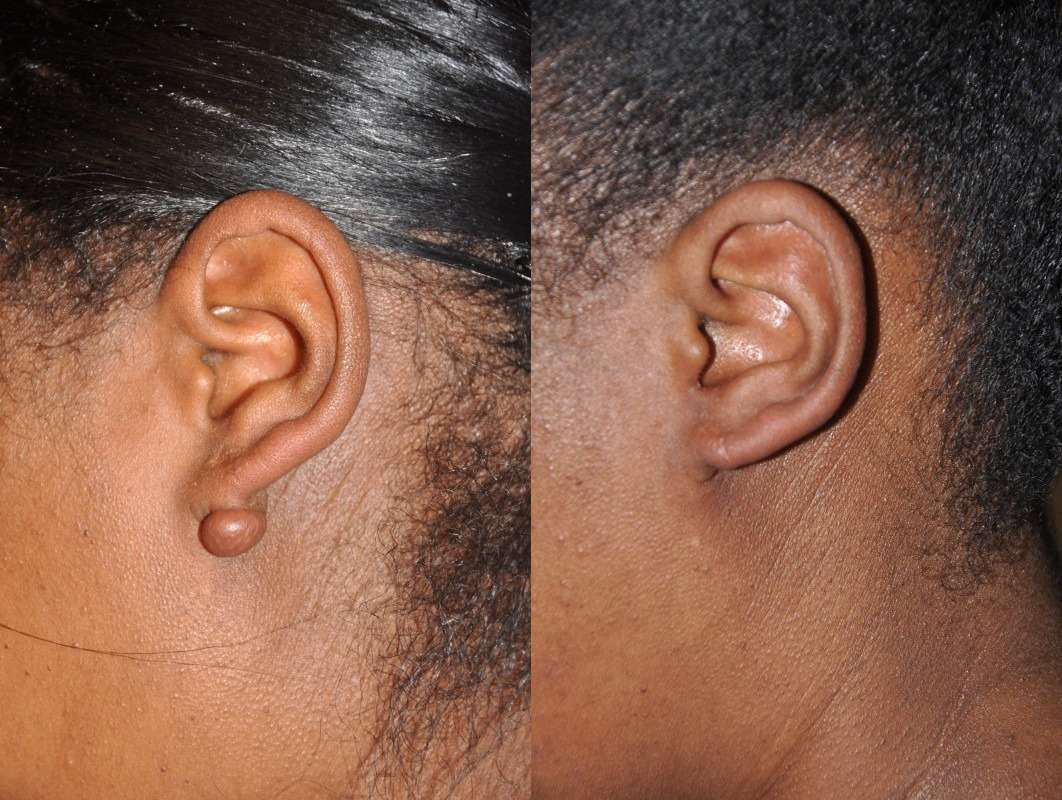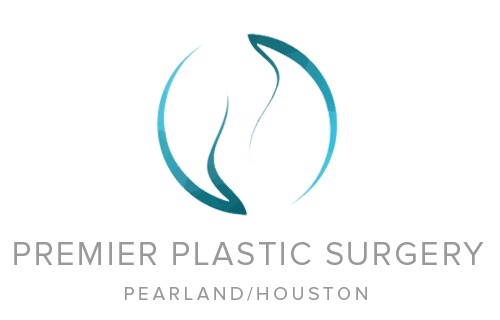
Keloid Removal in Houston, TX
Sometimes, the body is too good at healing itself – which is the case with keloid scars. The excessive overgrowth of scar tissue can be embarrassing, but you don’t have to continue living with it. Premier Plastic Surgery performs keloid scar treatment for residents in Houston, Pearland, Lake Jackson, and the surrounding areas of South Houston.
What is Keloid Scar Treatment?
Sometimes, the body is too good at healing itself – which is the case when you end up developing keloids. The excessive overgrowth of scar tissue can be embarrassing, but you don’t have to continue living with it. Dr. Hankins and his team at Premier Plastic Surgery are experts in treating and removing keloid scars for anyone looking to reduce the appearance of a scar.
Keloid scars are distinct from other types of scars (like hypertrophic scars) due to their invasive nature in adjacent normal tissue, causing them to progressively increase in size. This characteristic makes hypertrophic and keloid scars quite different. Keloids often result in large, unsightly scars that can be bothersome and problematic for the affected individuals. While this type of scar is more likely for those with darker skin, anyone can develop keloids.
Dr. Hankins offers a unique approach to keloid scar removal that does not involve the use of irradiation, which can have uncertain long-term effects. His protocol focuses on keloid excision and reconstruction, complemented by injections and laser therapy as needed to prevent scar recurrence. Patients seeking keloid scar removal should consider Dr. Hankins’ expertise and approach, as he has successfully treated many individuals, ensuring their satisfaction with the quality of their scars’ appearance post-treatment.
Keloid Scar Before & Afters
Benefits of Keloid Removal
Some of the more common benefits of keloid scar treatment include:
- Flattening, removal, or reduction in the size of the keloid scar
- Increased self-confidence
- Reduced pain, itching, or tenderness caused by the keloid scar
What Treatment Options Are Available for Keloids?
Keloid scar treatment may be based on the size and type of the keloid scar and the age of the patient, along with a variety of other contributing factors. Keloid scars can be treated with injections of either Kenalog or 5-FU (a chemotherapeutic agent), or excision (surgical removal) and laser treatment. At Premier Plastic Surgery, our recommended treatment is generally surgical. We enhance the procedure by injecting triamcinolone into the wound at the time of surgery. In selected cases, superficial radiation therapy or SRT can be given within 24 hours after surgery.
Surgical Options for Keloid Removal
Steroid injections are better for scars that are early in their evolution. I cannot emphasize enough the importance of bringing an evolving keloid scar to the attention of your surgeon or medical care provider early in its evolution before it gets too big. It is sometimes possible to abort that process early in its evolution whereas once a thick ropey scar has been established, its treatment becomes much more difficult. If the scar has been determined to be amenable to surgical excision or keloid surgery, then we have established a protocol with the use of lasers and injections as necessary to help prevent the recurrence of the scar once it has been excised.
Frequently Asked Questions about Keloid Removal
Why do keloid scars form?
A keloid scar often forms when the body does too good of a job of healing a wound, and the scar becomes bigger than the initial wound. It occurs when there is too much collagen in the skin, causing the scar to keep growing. What differentiates a keloid scar from one that is hypertrophic is the keloid scar will encroach on normal tissue and continue growing.
Does keloid scar removal treatment hurt?
Absolutely not. We use a local anesthetic and buffer that to a neutral ph prior to surgically removing a keloid scar so you won’t feel any pain or discomfort. As for injections, you may feel a little discomfort, but it’s typically very well tolerated. We do have ProNox, which is a patient controlled method of analgesia to assist relieve the pain and anxiety of the procedure. However, for the vast majority of patients, use of this modality is not necessary..
How do I know which treatment option is right for my keloid scar?
During your initial consultation, we will take your detailed medical history and Dr. Hankins will examine your keloid scar and determine the right treatment plan for you. All questions are answered before treatment is initiated.
Is there any way to prevent keloid scars?
The best method is prevention for those people with a high propensity to developing keloid scars. Regarding ear piercing which is a common source of such scars, make sure that it is done in a clean and safe environment. Promptly treat any inflammation of the piercing with antibiotics and keep the area clean and dry. Avoid any traction to the earrings in the new piercing. If you see the beginnings of a keloid despite taking preventative measures, seek medical attention right away so that the scar development can be arrested at an earlier stage. The earlier, the better.
Do keloid scars come back after removal?
Unfortunately, keloid scars can grow back. That’s why we recommend using laser treatment to inhibit the blood supply to the keloid scar and injections after surgery to keep them at bay. If you see a recurrence after treatment, you need to seek medical attention immediately rather than waiting for it “go away”. It will only get bigger.
Are some people more at risk for keloid scars?
Yes, it is true that people of some ethnicities are more prone to developing keloid scars. Moreover, any area of the body where there is a scar that is subject to a wide range of motion where the scar is put under tension at a high frequency can also prompt keloid scar formation. We have seen patients with keloid scars from procedures done at another practice from breast reductions where an incision is carried too far back of the lateral chest wall behind the breast in a well meaning but ill designed surgical plan to treat the extra skin and fat that often occurs there.
How long does keloid removal surgery typically take?
It depends on the size of the scar and where on the body it is located.
Is there anything I should do before keloid scar removal surgery?
Yes, come see a plastic surgeon, the earlier, the better.
Is there any downtime with keloid scar removal?
Scars excisions take approximately 2 – 3 weeks to heal.
Can I leave my keloid scar untreated?
Yes, doing nothing is always an option, but unfortunately, it will grow bigger and harder to treat.
How long is the recovery period after keloid scar removal surgery?
In just about all cases, the keloid scar excision should be completely sealed and watertight within 2 weeks of surgery. All stitches are buried so there are no sutures to remove on follow-up.”},
Is keloid removal right for me?
If you’re an adult man or woman for whom a keloid scar is causing you embarrassment, discomfort, or difficulty, you’re likely a good candidate for keloid scar treatment. Keloid scars can come in all shapes, sizes, and colors, so regardless of what yours looks like, you can still be a good candidate for keloid removal.
What is a keloid scar? How does it differ from other scars?
The difference between a keloid scar and a regular scar is that a keloid scar by definition will invade adjacent normal tissue, so that the scar progressively grows in size.\u00a0 This results in large, unsightly scars that can be problematic and bothersome to the patient.
What type of anesthesia is typically used for keloid scar removal surgery?
Although some keloid scars require surgery for removal and the restoration of a more normal appearance, the good news as these can be done in the vast majority of cases under local anesthesia.
Are there any potential complications or side effects associated with the surgical procedure
As with any surgical procedure, there is always the risk of bleeding, scarring and infection. We have not seen any recurrence of keloid scars and our patient population provided they are compliant with treatment recommendations.
How many treatments or follow-up appointments are needed for the best results?
The vast majority of keloid scars can be treated within our protocol that last approximately 3 months. On some occasions, the treatment interval may need to be longer particularly with presternal scars. Fortunately with the presternal keloid scars, no effective surgical strategy has yet been developed and many of these are exacerbated by other practitioners who have attempted to excise and close these in the presternal area.
Will you be able to see the scar after keloid scar removal?
Once an incision or an injury to the dermis has occurred, a scar is formed, and the scar is permanent. However, in the vast majority of cases, the quality of the scar would rank in the good to excellent category, much to the delight of our patients.
What kind of scarring can one expect after keloid scar removal?
So long as the patient is completely compliant with her treatment recommendations, we can routinely obtain good excellent results.
How Much Does Keloid Scar Treatment Cost in Houston, TX?
Sometimes insurance can be applied to keloid treatment, but every case is different. When you come in for your consultation with Dr. Hankins we can discuss the cost of your procedure, whether insurance applies and financing options, if necessary.
If you’d like more information about keloid scar treatment, contact our knowledgeable, helpful staff to ask questions or schedule a free consultation. The team at Premier Plastic Surgery is proud to serve the residents of Houston, Pearland, Lake Jackson and the neighboring areas of South Houston.
Keloid Removal in Houston, TX
Sometimes, the body is too good at healing itself – which is the case with keloid scars. The excessive overgrowth of scar tissue can be embarrassing, but you don’t have to continue living with it. Premier Plastic Surgery performs keloid scar treatment for residents in Houston, Pearland, Lake Jackson, and the surrounding areas of South Houston.
What is Keloid Scar Treatment?
Sometimes, the body is too good at healing itself – which is the case when you end up developing keloids. The excessive overgrowth of scar tissue can be embarrassing, but you don’t have to continue living with it. Dr. Hankins and his team at Premier Plastic Surgery are experts in treating and removing keloid scars for anyone looking to reduce the appearance of a scar.
Keloid scars are distinct from other types of scars (like hypertrophic scars) due to their invasive nature in adjacent normal tissue, causing them to progressively increase in size. This characteristic makes hypertrophic and keloid scars quite different. Keloids often result in large, unsightly scars that can be bothersome and problematic for the affected individuals. While this type of scar is more likely for those with darker skin, anyone can develop keloids.
Dr. Hankins offers a unique approach to keloid scar removal that does not involve the use of irradiation, which can have uncertain long-term effects. His protocol focuses on keloid excision and reconstruction, complemented by injections and laser therapy as needed to prevent scar recurrence. Patients seeking keloid scar removal should consider Dr. Hankins’ expertise and approach, as he has successfully treated many individuals, ensuring their satisfaction with the quality of their scars’ appearance post-treatment.
Keloid Scar Before & Afters
Benefits of Keloid Removal
Some of the more common benefits of keloid scar treatment include:
- Flattening, removal, or reduction in the size of the keloid scar
- Increased self-confidence
- Reduced pain, itching, or tenderness caused by the keloid scar
What Treatment Options Are Available for Keloids?
Keloid scar treatment may be based on the size and type of the keloid scar and the age of the patient, along with a variety of other contributing factors. Keloid scars can be treated with injections of either Kenalog or 5-FU (a chemotherapeutic agent), or excision (surgical removal) and laser treatment. At Premier Plastic Surgery, our recommended treatment is generally surgical. We enhance the procedure by injecting triamcinolone into the wound at the time of surgery. In selected cases, superficial radiation therapy or SRT can be given within 24 hours after surgery.
Surgical Options for Keloid Removal
Steroid injections are better for scars that are early in their evolution. I cannot emphasize enough the importance of bringing an evolving keloid scar to the attention of your surgeon or medical care provider early in its evolution before it gets too big. It is sometimes possible to abort that process early in its evolution whereas once a thick ropey scar has been established, its treatment becomes much more difficult. If the scar has been determined to be amenable to surgical excision or keloid surgery, then we have established a protocol with the use of lasers and injections as necessary to help prevent the recurrence of the scar once it has been excised.
Frequently Asked Questions about Keloid Removal
Why do keloid scars form?
A keloid scar often forms when the body does too good of a job of healing a wound, and the scar becomes bigger than the initial wound. It occurs when there is too much collagen in the skin, causing the scar to keep growing. What differentiates a keloid scar from one that is hypertrophic is the keloid scar will encroach on normal tissue and continue growing.
Does keloid scar removal treatment hurt?
Absolutely not. We use a local anesthetic and buffer that to a neutral ph prior to surgically removing a keloid scar so you won’t feel any pain or discomfort. As for injections, you may feel a little discomfort, but it’s typically very well tolerated. We do have ProNox, which is a patient controlled method of analgesia to assist relieve the pain and anxiety of the procedure. However, for the vast majority of patients, use of this modality is not necessary..
How do I know which treatment option is right for my keloid scar?
During your initial consultation, we will take your detailed medical history and Dr. Hankins will examine your keloid scar and determine the right treatment plan for you. All questions are answered before treatment is initiated.
Is there any way to prevent keloid scars?
The best method is prevention for those people with a high propensity to developing keloid scars. Regarding ear piercing which is a common source of such scars, make sure that it is done in a clean and safe environment. Promptly treat any inflammation of the piercing with antibiotics and keep the area clean and dry. Avoid any traction to the earrings in the new piercing. If you see the beginnings of a keloid despite taking preventative measures, seek medical attention right away so that the scar development can be arrested at an earlier stage. The earlier, the better.
Do keloid scars come back after removal?
Unfortunately, keloid scars can grow back. That’s why we recommend using laser treatment to inhibit the blood supply to the keloid scar and injections after surgery to keep them at bay. If you see a recurrence after treatment, you need to seek medical attention immediately rather than waiting for it “go away”. It will only get bigger.
Are some people more at risk for keloid scars?
Yes, it is true that people of some ethnicities are more prone to developing keloid scars. Moreover, any area of the body where there is a scar that is subject to a wide range of motion where the scar is put under tension at a high frequency can also prompt keloid scar formation. We have seen patients with keloid scars from procedures done at another practice from breast reductions where an incision is carried too far back of the lateral chest wall behind the breast in a well meaning but ill designed surgical plan to treat the extra skin and fat that often occurs there.
How long does keloid removal surgery typically take?
It depends on the size of the scar and where on the body it is located.
Is there anything I should do before keloid scar removal surgery?
Yes, come see a plastic surgeon, the earlier, the better.
Is there any downtime with keloid scar removal?
Scars excisions take approximately 2 – 3 weeks to heal.
Can I leave my keloid scar untreated?
Yes, doing nothing is always an option, but unfortunately, it will grow bigger and harder to treat.
How long is the recovery period after keloid scar removal surgery?
In just about all cases, the keloid scar excision should be completely sealed and watertight within 2 weeks of surgery. All stitches are buried so there are no sutures to remove on follow-up.”},
Is keloid removal right for me?
If you’re an adult man or woman for whom a keloid scar is causing you embarrassment, discomfort, or difficulty, you’re likely a good candidate for keloid scar treatment. Keloid scars can come in all shapes, sizes, and colors, so regardless of what yours looks like, you can still be a good candidate for keloid removal.
What is a keloid scar? How does it differ from other scars?
The difference between a keloid scar and a regular scar is that a keloid scar by definition will invade adjacent normal tissue, so that the scar progressively grows in size.\u00a0 This results in large, unsightly scars that can be problematic and bothersome to the patient.
What type of anesthesia is typically used for keloid scar removal surgery?
Although some keloid scars require surgery for removal and the restoration of a more normal appearance, the good news as these can be done in the vast majority of cases under local anesthesia.
Are there any potential complications or side effects associated with the surgical procedure
As with any surgical procedure, there is always the risk of bleeding, scarring and infection. We have not seen any recurrence of keloid scars and our patient population provided they are compliant with treatment recommendations.
How many treatments or follow-up appointments are needed for the best results?
The vast majority of keloid scars can be treated within our protocol that last approximately 3 months. On some occasions, the treatment interval may need to be longer particularly with presternal scars. Fortunately with the presternal keloid scars, no effective surgical strategy has yet been developed and many of these are exacerbated by other practitioners who have attempted to excise and close these in the presternal area.
Will you be able to see the scar after keloid scar removal?
Once an incision or an injury to the dermis has occurred, a scar is formed, and the scar is permanent. However, in the vast majority of cases, the quality of the scar would rank in the good to excellent category, much to the delight of our patients.
What kind of scarring can one expect after keloid scar removal?
So long as the patient is completely compliant with her treatment recommendations, we can routinely obtain good excellent results.
How Much Does Keloid Scar Treatment Cost in Houston, TX?
Sometimes insurance can be applied to keloid treatment, but every case is different. When you come in for your consultation with Dr. Hankins we can discuss the cost of your procedure, whether insurance applies and financing options, if necessary.
If you’d like more information about keloid scar treatment, contact our knowledgeable, helpful staff to ask questions or schedule a free consultation. The team at Premier Plastic Surgery is proud to serve the residents of Houston, Pearland, Lake Jackson and the neighboring areas of South Houston.
